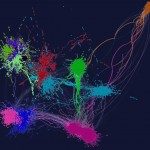Link to Pubmed [PMID] – 34415528
Link to DOI – 10.1007/978-1-0716-1390-0_1
Methods Mol Biol 2022 ; 2301(): 1-15
Over the last decade, genomic proximity ligation approaches have reshaped our vision of chromosomes 3D organizations, from bacteria nucleoids to larger eukaryotic genomes. The different protocols (3Cseq, Hi-C, TCC, MicroC [XL], Hi-CO, etc.) rely on common steps (chemical fixation digestion, ligation…) to detect pairs of genomic positions in close proximity. The most common way to represent these data is a matrix, or contact map, which allows visualizing the different chromatin structures (compartments, loops, etc.) that can be associated to other signals such as transcription, protein occupancy, etc. as well as, in some instances, to biological functions.In this chapter we present and discuss the filtering of the events recovered in proximity ligation experiments as well as the application of the balancing normalization procedure on the resulting contact map. We also describe a computational tool for visualizing normalized contact data dubbed Scalogram.The different processes described here are illustrated and supported by the laboratory custom-made scripts pooled into “hicstuff,” an open-access python package accessible on github ( https://github.com/koszullab/hicstuff ).


